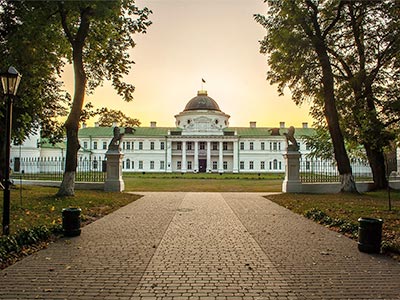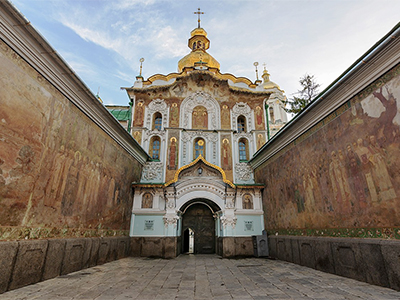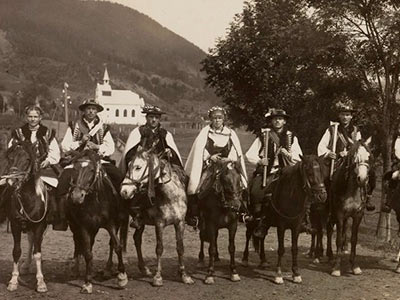 13.01.2024
Kachanivka, Eden on Earth
13.01.2024
Kachanivka, Eden on EarthThe Kachanivka Park spreads over an area of 570 hectares (1407 acres) which makes it the biggest park in Ukraine and one of the biggest in Europe. 130 hectares of this area are ponds. There are several architectural landmarks of considerable architectural and historical value on the estate. Other man-made features include bridges, earthworks, gazebos, etc., and add to the overall architectural set-up of the park. Dozens of species of trees, hundreds of species of other plants, lanes and paths meandering through the Park, make it a place of paradisiacal beauty.
There is a place in the Chernihiv Oblast’ (about 250 kilometers from Kyiv and about the same distance from the town of Chernihiv) which is called Kachanivka. It used to be a sprawling estate of the Tarnovskys of exceptional beauty and now it is a park (officially: “National Preserve”, maintained and protected by the state of Ukraine. The park happens to be not only one of the biggest in Europe but also one of the oldest surviving parks, and one of the most beautiful. Of course, “beautiful” is a very subjective category, especially applied to a park but no one who visits the park fails to be enchanted by it. In the 19th century the estate of Kachanivka was regularly visited by many prominent, and untold numbers of not so prominent, musicians, painters and poets, among who one finds figures of world fame: the composer M. Hlynka and the writer M. Gogol. Taras Shevchenko, a leading figure in the Ukrainian culture of the first half of the 19th century, was a guest of the Tarnovskys, the owners of the Kachanivka estate, on many occasions. It was in Kachanivka that he met a woman who was believed to have been the greatest love of his life. Travelling to Ukraine.
Harmony of Architecture and Scenery
The central architectural landmark of the estate was and is a majestic palace built in the classicist style of the early 19th century. It is a two-storied structure of eighty rooms and spacious halls with wonderful views opening from all the windows. Two smaller I buildings on the north and on the east sides of the palace form a huge inner yard separated on one side from the park with a cast- iron lattice-work fence. There is a lovely, typical early-nineteenth century church that stands some distance away from the palace, right opposite It, at the end of a treelined lane. In the vault of the church members of the Tarnavsky family used to be burled, A number of gazebos, belvederes and summerhouses used to grace the park at many places, of which but a few have remained standing until now. One of them, known as the Hlynka’s Gazebo, commands an exciting view of ponds and lush vegetation. Of several stone bridges only three have been preserved and they, together with “romantic ruins” add to the general emotionally uplifting atmosphere of the park. Other buildings of the estate used to house offices; among outbuildings there were, of course, a coach house, a kennel, a cow shed, a gardener’s house. All these buildings are now occupied by the curator and management of the Kachanivka Preserve, a library, a sort of a hotel. Among the irreparable losses, particularly damaging to the overall impression once created by the estate are a green house and a lot of pieces of marble and cast sculpture (only one has miraculously survived). Visitors to the park in the twenties of this century reported having seen piles of broken sculpture in many parts of the park.
Unfortunately, Kachanivka has suffered not only architectural and sculptural lasses in the 20th century, A considerable number of age-old trees was chopped down in the twenties for timber but the damage was not too great and the park was not denuded of its abundant vegetation. One of the most attractive features of the park are its numerous ponds. The park was arranged in such a way so as to provide changing views when one took a walk or a horse ride through it. These views, changing virtually with every step, produced different impressions which, in turn, created various moods. The lanes and paths ran and meandered among the low hills and climbed on top of them. Some of the paths took one to the dark, shady places roofed with branches and crowns of mighty trees but only a few more steps would take one to a summit dominating a sunlit panoramic view. There were gazebos to watch the sunups from, and the ones to sit in and watch the sunsets. One of the hills, situated in the part of the park that used to be known as “Switzerland” provided a view with “three waters,” that is three ponds on three different sides of the hill, each of the ponds with its own special mood.
The trees themselves, of which there were many species (and to a large extent still are) no doubt contributed to the creation of the general impression of the park by the differences in color of the verdure, texture of the bark of the boles. In one part of the park, for example, a sort of mournful mood was created by a raw of dark firs planted in front of a grove of trees with leaves of much lighter green color. The loss of the Tomovsky owners of the pork in the late 19th century called it “Edem” (“Eden”) and made a purposeful effort to create on earth something that could by rights be called a paradisiacal garden which would afford an elevation of spirit and return of physical energies to anyone who sought such revitalization.
History of Kachanivka
In the early 18th century there was a khutir (a very small village or a farmstead) sitting at a very picturesque place at the river Smosh. It had belonged to a succession of owners before it was sold, in 1744, to Fedir Kachenivsky, a man of presumably noble birth and a singer of the Imperial choir of Her Imperial Majesty Elizabeth Petrivna, the Empress of Russia (Ukraine at that time was already a part of the Russian Empire). Because of the new owner’s name the place soon got renamed to “Kachanivka”. In 1770 Kachanivka was bought on the order of Catherine the Great for her favorite, the Held Marshal Rumyantsev-Zadunaisky and consequently “given” to him as a present. Though there was a garden laid there and a big stone house built, the Field Marshall did not come to Kachanivka to stay for any considerable length of time. The estate was passed on to his son and it was sold to a new owner in 1808. The estate changed hands a couple of times before it came into the possession of Hryhoriy Tarnovsky. It is with Tarnovsky that the fame of Kachanivka began. Tarnovsky had a palace built and a huge park laid out. He was a patron of arts and financially backed painters, poets and musicians. In the thirties and the forties of the nineteenth century the Kachanivka estate was visited, among so many others, by the poet Shevchenko and the musician Hlynka. Tarnovsky had an orchestra at Kachanivka which was the first to play some of the musical pieces, created by Hlynka in Kachanivka.
In 1853 Hryhoriy Tarnovsky died (his wife died on the same day and they had no children) and the estate was inherited by his close relative Vasyl Tarnovsky, Sr. He continued improving the estate but his main preoccupation was with public affairs. It was after 1866 when the estate passed after his death on to his son, Vasyl Tarnovsky, Jr., that Kachanivka went through its most flourishing period. Vasyl Tarnovsky, Jr. was a man with very colourful and controversial personality who combined a great love for the Ukrainian heroic past and for collecting all kinds of Ukrainian curios with an equally great passion for women. He was a petty tyrant and at the same time it is thanks to Mm that a lot of things connected with Taras Shevchenko have been preserved for the grateful posterity. A stream of poets, writers, musicians and painters who continually kept coming to, and staying at Kachanivka turned the estate into a veritable art center. His collection of precious items from the Ukrainian past, of paintings, manuscripts and arms could rival that of a good-sized museum. The Russian painter Repin who was among the guests at Kachanivka, made sketches there for his famous painting The Cossacks Writing a Letter to the Turkish Sultan. Tarnovsky, who loved his park dearly, devoted much of his time and a great deal of his seemingly inexhaustible energies to turning it “into a paradise on earth.”
In 1897 Vasyl Tarnovsky, Jr., realizing he had been financially ruined by the expenses that the upkeep of the park and his collection required, sold Kachanivka to Pavlo Kharytonenko, an Industrialist. Tarnovsky had willed his collection to a museum and many items from it have survived and are kept in the museums of Kyiv and Chernihiv. Kharytonenko did not neglect his duties of an owner of a unique estate and enlarged the park, renovated the palace and improved the general maintenance of the place. It continued to attract numerous intellectuals from Ukraine and from St. Petersburg in Russia.
Later the estate passed on to Kharytonenko’s daughter Olena and her husband Mykhailo Oliv. Kachanivka was paid a visit, among innumerable others, by two distinguished painters of the time -Dobuzhynsky and Petrov-Vodkin.
The time of cruel trials arid tribulations for Kachanivka came after 1917 when the | Revolution had swept through the land. The | owners of Kachanivka had to flee to save |their lives, the estate was ravaged. What could not be carried away was destroyed. | The palace was used as a shelter for home| less children, then it was converted into a rest home, then a hospital. But by the decree of fate, or by God’s intervention Kachanivka has been preserved more or less intact as far as its park and major architectural landmarks are concerned. No new big ugly houses have been built, most of the trees have been preserved, the ponds have not been drained. The palace has lost all its furniture but has remained standing,
It seemed for a time that a gloomy, prophesy, made once by Taras Shevchenko when on a visit to Kachanivka, had begun to come true. Speaking to Vasyl Tarnovsky, Jr., who was a great admirer of the poet, Shevchenko, looking at the gorgeous, paradisiacal park, said wistfully: «Vasyl, delay will come when everything here, at your estate, will become overgrown with thistles and nettles and grazing cows will look Into the windows of your palace.”
In 1981 Kachanivka was given the status of “the State Historical and Cultural Preserve” which has saved if from further ruin. A much greater effort Is needed though to keep maintaining It at a decent level of preservation, and still greater effort will have to be Involved In turning It into a major tourist center. The place has an enormous tourist potential.
Tarnovskys and Shevchenko
The Tarnovsky were a large family of people whose origins could be traced several generations back into the seventeenth century. Each of the three Tarnovskys, successive owners of Kachanivka, was a powerful personality indeed, with conflicting traits of character united in one person. Each of them cared for the arts, music and literature and at the same time enjoyed pleasures of the flesh. All these characteristic features of the Tarnavskys were revealed with a particularly stunning force In Vasyl Tarnovsky, Jr. He had three driving passions: his park, his collection and sex, probably in this order of precedence. His Shevchenko memorabilia collection alone had a half thousand items in it!
He was a gourmet and dined and wined his guests sumptuously. He enjoyed a good drink but admitted that his father beat him at it by far, claiming that Tarnovsky Senior had been so thoroughly «alcoholized» that his body after his death and burial in the family vault in the local church had not decayed but remained mummified and could be exhibited as a «saint, miraculously preserved^ On his wedding day Vasyl Tarnovsky, Jr., had a pipe laid extending from a local vodka distillery to his park and a fountain was spouting vodka for a couple of days. Dozens and dozens of peasants from nearby villages, men and women alike, congregated at the fountain, drinking and filling vessels of every description. The place was described as looking like a battlefield with bodies strewn all around. Some did die of excessive drinking. Vasyl Tarnovsky was a man of violent temper and at least on one instance was known to have shot a man for trying to chop down a tree in his park. A lot more could be said of Tarnovsky along the same line and it makes him a person of many dimensions, but for us he remains primarily the creator of «a little paradise on earth. »
Taras Shevchenko, whom Tarnovsky greatly revered and loved as a poet, has usually been put forward as a sort of a classical figure to be studied at school and admired for His refusal to accept suppression of freedom and social injustice, a poet who poeticized Ukraine and her enchanting landscapes. But he was also a man, a human being of flesh and blood, eager to Love and to be loved, and not only in a lofty spiritual way. It was in Kachanivka that Shevchenko met his, probably, greatest love of his life, Nadiya Tarnovska. She was a relative of the Tarnovskys and with her four sisters lived for a stretch of time in Kachanivka. Shevchenko was introduced to Hryhoriy Tarnovsky by his friend, the painter Shternberg back in 1838. At that time, she was 18, not exactly beautiful but very attractive in a quiet way, with an excellent voice and a general womanly irresistible charm. Alas for Shevchenko his love was not reciprocated. He kept coming back, kept pressing her into accepting his love, marrying him but she refused to have an affair with him and rejected his proposal of marriage as well. Shevchenko grew very bitter and wrote one very angry and somewhat indecent poem but never had it published. Only two lines in an album at the Tarnovsky’s house are known to have been written by Shevchenko about Kachanivka and the person he cared so much for, who lived there:
And the path which you have trodden
Has overgrown with thistles…
She never married and destroyed all her correspondence, so there is only one letter preserved from Shevchenko to her which shows the depth of his tender feelings.
Kachanivka has opened new dimensions in many people, inspired love and poetic expressions, has been painted by many a pointer. And hopefully will continue to do so in future.
-
 27.02.2024
World of pysanka
Embark on a journey into the captivating world of Pysanka, the Ukrainian...
27.02.2024
World of pysanka
Embark on a journey into the captivating world of Pysanka, the Ukrainian...
-
 29.01.2024
Exploring the Treasures of Kyiv’s Lavra Monastery
In the heart of Kyiv lies the venerable Lavra Monastery, a testament...
29.01.2024
Exploring the Treasures of Kyiv’s Lavra Monastery
In the heart of Kyiv lies the venerable Lavra Monastery, a testament...
-
 05.01.2024
Hutsuls: passionate and Freedom-Loving
Hutsul men used to carry weapons with them, pistols and axes on...
05.01.2024
Hutsuls: passionate and Freedom-Loving
Hutsul men used to carry weapons with them, pistols and axes on...

